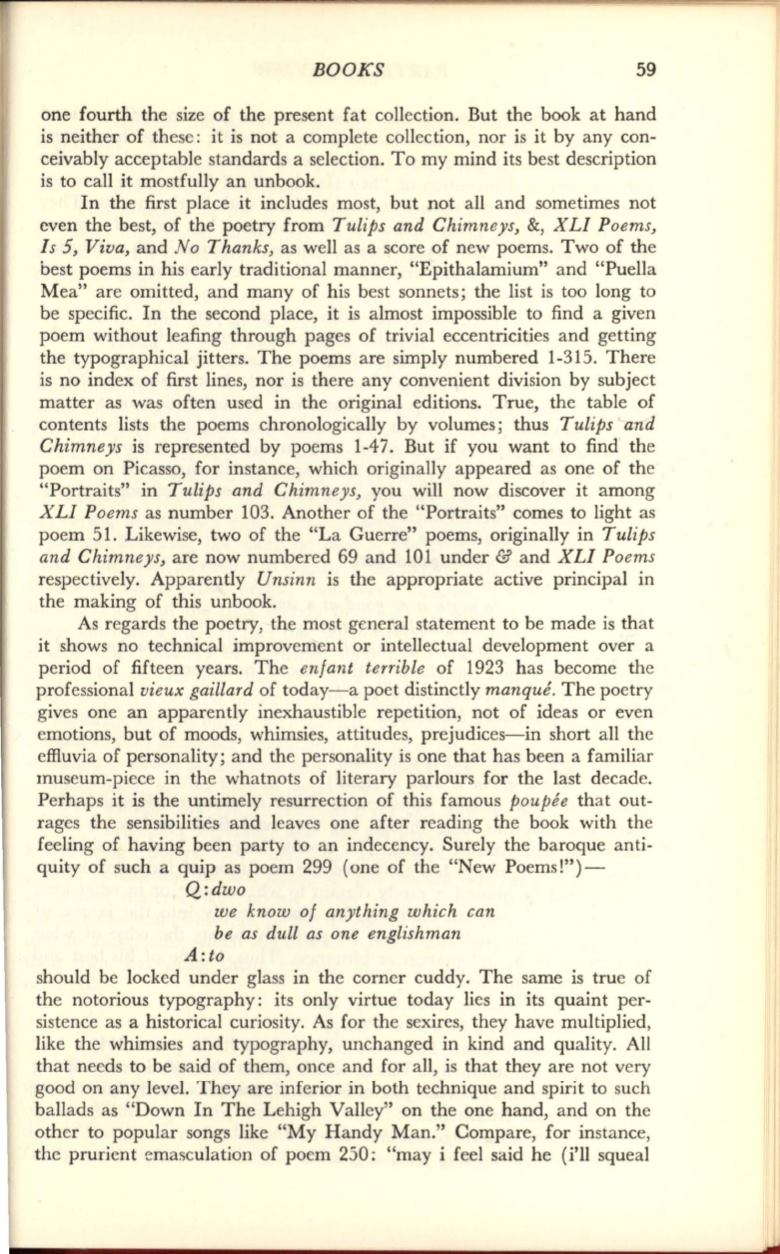
BOOKS
59
one fourth the size of the present fat collection. But the book at hand
is neither of these: it is not a complete collection, nor is it by any con–
ceivably acceptable standards a selection. To my mind its best description
is to call it mostfully an unbook.
In the first place it includes most, but not all and sometimes not
even the best, of the poetry from
Tulips and Chimneys,
&,
XLI Poems,
Is
5,
Viva,
and
No Thanks,
as well as a score of new poems. Two of the
best poems in his early traditional manner, "Epithalamium" and "Puella
Mea" are omitted, and many of his best sonnets; the list is too long to
be specific. In the second place, it is almost impossible to find a given
poem without leafing through pages of trivial eccentricities and getting
the typographical jitters. The poems are simply numbered
1-315.
There
is no index of first lines, nor is there any convenient division by subject
matter as was often used in the original editions. True, the table of
contents lists the poems chronologically by volumes; thus
Tulips and
Chimneys
is represented by poems 1-47. But if you want to find the
poem on Picasso, for instance, which originally appeared as one of the
"Portraits" in
Tulips and Chimneys,
you will now discover it among
XLI Poems
as number 103. Another of the "Portraits" comes to light as
poem
51.
Likewise, two of the "La Guerre" poems, originally in
Tulips
and Chimneys,
are now numbered 69 and
101
under
&
and
XLI Poems
respectively. Apparently
Unsinn
is the appropriate active principal in
the making of this unbook.
As regards the poetry, the most general statement to be made is that
it shows no technical improvement or intellectual development over a
period of fifteen years. The
enfant terrible
of
1923
has become the
professional
vieux gaillard
of today-a poet distinctly
manque.
The poetry
gives one an apparently inexhaustible repetition, not of ideas or even
emotions, but of moods, whimsies, attitudes, prejudices-in short all the
efHuvia of personality; and the personality is one that has been a familiar
museum-piece in the whatnots of literary parlours for the last decade.
Perhaps it is the untimely resurrection of this famous
poupee
that out–
rages the sensibilities and leaves one after reading the book with the
feeling of having been party to an indecency. Surely the baroque anti–
quity of such a quip as poem
299
(one of the "New Poems!")-
Q:dwo
we know of anything which can
be as dull as one englishman
A:to
should be locked under glass in the corner cuddy. The same is true of
the notorious typography: its only virtue today lies in its quaint per–
sistence as a historical curiosity. As for the sexires, they have multiplied,
like the whimsies and typography, unchanged in kind and quality. All
that needs to be said of them, once and for all, is that they are not very
good on any level. They are inferior in both technique and spirit to such
ballads as "Down In The Lehigh Valley" on the one hand, and on the
other to popular songs like "My Handy Man." Compare, for instance,
the prurient emasculation of poem
250:
"may i feel said he (i'll squeal


